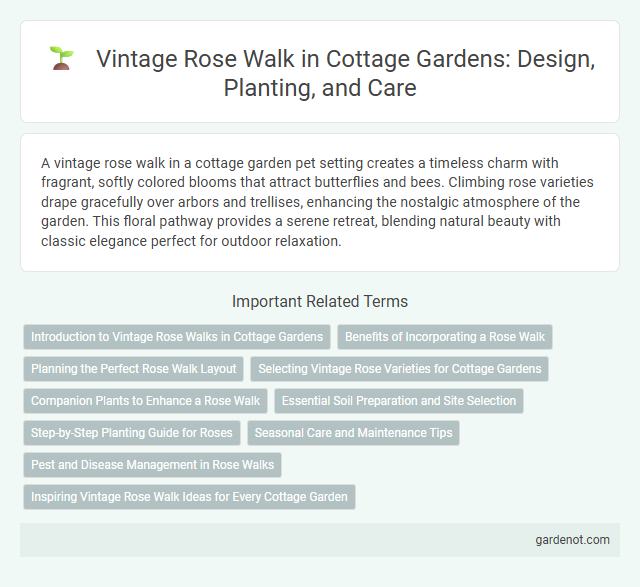A vintage rose walk in a cottage garden pet setting creates a timeless charm with fragrant, softly colored blooms that attract butterflies and bees. Climbing rose varieties drape gracefully over arbors and trellises, enhancing the nostalgic atmosphere of the garden. This floral pathway provides a serene retreat, blending natural beauty with classic elegance perfect for outdoor relaxation.
Introduction to Vintage Rose Walks in Cottage Gardens
Vintage Rose Walks in cottage gardens evoke timeless charm with climbing old-fashioned rose varieties like Damask, Gallica, and Alba, renowned for their rich fragrance and delicate blooms. These walks create enchanting pathways framed by lush greenery and softly colored petals, enhancing the romantic, nostalgic atmosphere synonymous with traditional English garden design. Integrating heirloom roses supports biodiversity and connects garden spaces to historical horticulture, enriching the sensory and visual experience.
Benefits of Incorporating a Rose Walk
Incorporating a vintage rose walk into a cottage garden enhances aesthetic appeal by showcasing fragrant, heirloom rose varieties that attract pollinators such as bees and butterflies. This structured pathway creates a serene, immersive experience while promoting biodiversity and supporting local ecosystems. Additionally, the rose walk adds seasonal color, texture, and creates natural privacy, increasing the garden's overall value and charm.
Planning the Perfect Rose Walk Layout
Planning the perfect rose walk layout involves selecting climbing vintage rose varieties known for their fragrance and repeat blooming, such as Old Blush or Zephirine Drouhin. Positioning roses along a curved or straight path enhances the garden's aesthetic and creates an inviting atmosphere for leisurely strolls. Incorporating complementary plants like lavender or catmint helps improve soil health and adds seasonal color contrast around the rose archways.
Selecting Vintage Rose Varieties for Cottage Gardens
Choosing vintage rose varieties for a cottage garden involves selecting hardy, fragrant blooms such as Gallica, Damask, or Alba roses that thrive in informal, natural settings. These roses offer rich colors and strong scents, enhancing the quaint charm of cottage-style landscapes. Incorporating disease-resistant cultivars like 'Madame Hardy' or 'Celsiana' ensures longevity and low maintenance in traditional cottage gardens.
Companion Plants to Enhance a Rose Walk
Companion plants such as lavender, catmint, and sweet alyssum enhance a vintage rose walk by attracting beneficial pollinators and deterring pests naturally. Perennials like foxgloves and delphiniums provide vertical contrast and extend blooming seasons alongside antique roses. Incorporating fragrant herbs like rosemary and thyme enriches sensory appeal while improving soil health in the cottage garden setting.
Essential Soil Preparation and Site Selection
Selecting a well-drained site with partial sunlight is crucial for establishing a thriving vintage rose walk in a cottage garden. Essential soil preparation involves enriching the soil with organic matter, such as compost or aged manure, to improve fertility and drainage, ensuring a loose, aerated environment for root development. Testing soil pH and adjusting it to a slightly acidic range of 6.0 to 6.5 optimizes nutrient uptake and promotes vigorous growth and abundant blooms.
Step-by-Step Planting Guide for Roses
Start by selecting a sunny location with well-drained soil for your vintage rose walk, ensuring at least six hours of sunlight daily. Prepare the planting site by loosening the soil and mixing in organic compost to improve fertility and drainage. Plant rose bushes at the same depth they were in their nursery pots, spacing them about 2 to 3 feet apart to promote healthy air circulation and growth.
Seasonal Care and Maintenance Tips
Vintage rose walks thrive with consistent seasonal care, including pruning in late winter to promote healthy growth and airflow. Fertilize roses in early spring using balanced, slow-release nutrients to enhance blooming and vigor. Regularly monitor for pests and diseases throughout the growing season to maintain optimal plant health and extend flowering periods.
Pest and Disease Management in Rose Walks
Effective pest and disease management in vintage rose walks involves regular monitoring for common threats such as aphids, spider mites, and black spot disease. Implementing integrated pest management (IPM) techniques, including natural predators like ladybugs and organic fungicides, reduces chemical dependency and promotes plant health. Proper pruning and adequate air circulation further minimize fungal infections and ensure a vibrant, disease-resistant rose garden.
Inspiring Vintage Rose Walk Ideas for Every Cottage Garden
Inspiring vintage rose walk ideas transform any cottage garden into a timeless retreat filled with fragrant heirloom roses such as 'Damask', 'Moss', and 'Old Blush'. Incorporate wrought iron arches or wooden trellises draped with climbing roses to create enchanting pathways that evoke classic English garden charm. Combining mixed borders of lavender, foxglove, and delphinium enhances the nostalgic feel while supporting a diverse pollinator habitat.
Vintage rose walk Infographic

 gardenot.com
gardenot.com